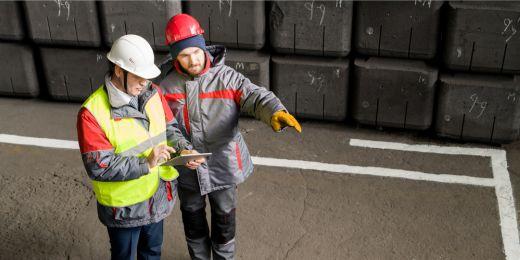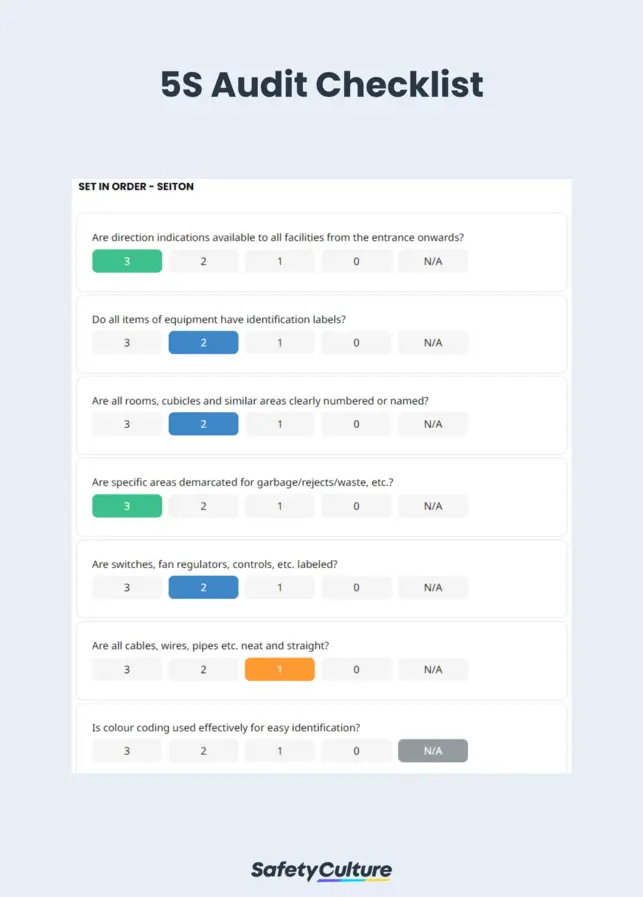What is a 5S Audit Checklist?
A 5S audit checklist is a tool used for performing 5S audits in the workplace. It can help evaluators determine if workers follow 5S standards correctly and reinforce conformance with 5S principles at all times. They can tailor this checklist according to the specific needs of their organization.
What is 5S Audit?
The 5S audit is the systematic approach to identifying improvement opportunities in the workplace. It generally observes the proper implementation of 5S in the work area which stands for the 5 steps of this methodology—Seiri (Sort), Seiton (Systematize), Seiso (Shining), Seiketsu (Standardizing), and Shitsuke (Sustaining).
Benefits of Performing 5S Audits
Carrying out 5S audits is key to reinforcing these standards consistently in the organization. With the help of these checks, organizations can:
- Identify and eliminate activities that don’t add value to the operations
- Standardize work processes and procedures for better efficiency
- Detect and resolve potential safety hazards in the workplace
- Maintain high standards of cleanliness and organization in workspaces
- Increase employee engagement through involvement in 5S activities
Implementing the 5S system may appear small and trivial at first, but these small changes, when repeated over time, will eventually lead to bigger results. This system can also be used with other methods and systems, such as the 5W1H method.
Why Should You Use a Checklist for 5S Audits?
Checklists play an essential role in ensuring a consistent and effective auditing process for 5S principles. It supports the organization’s efforts to achieve and sustain 5S excellence in the workplace.
Here are 5 great reasons why you should start using 5S audit checklist templates:
- Standardization – A 5S checklist a handy outline of criteria, requirements, and expectations for each of the 5S elements ensures all audits are performed the same way throughout the organization, regardless of who performs the process.
- Focus and Structure –With a structured approach to 5S audits, auditors can assess different work areas consistently without missing critical points.
- Comprehensive Coverage – A well-designed checklist ensures that no important areas are overlooked and that any potential deficiencies are captured.
- Documentation – They not only provide a historical trail of audit results but also serve as reference points for tracking progress and following up on corrective actions.
- Continuous Improvement – With the help of checklists, organizations can boost their 5S efforts, which can lead to improved operational performance and better productivity.
What to Include in Your 5S Audit Checklist
5S checklists are a valuable resource for carrying out 5S audits in the workplace. Here’s a quick rundown of the essential items to cover in your 5S audit checklist:
- Sort – Make sure that only the required tools, equipment, furniture, spare parts, and materials are present in the work area. Clear away all tripping hazards, such as around the vicinity of places designated for walking, standing, and working.
- Set in Order – Ensure that equipment, machinery, and tools, among others, are placed in identifiable locations and clearly labeled.
- Shine – Free work areas from dirt, debris, obstructions, and other unnecessary items that can hinder working efficiently and safely.
- Standardize – Store tools, equipment, furniture, and paperwork in designated areas, immediately after each use.
- Sustain – Uphold consistent observation of the 5S system and recognize those who show a commitment to maintaining organized, efficient, and standardized workplace practices.
If you want to know more about the detailed items for the 5S audit checklist, visit 5S Principles.
Increase Team Efficiency Through 5S Training
Integrate 5S training into your daily operations through SafetyCulture’s Training feature. This feature allows you to customize and deploy 5S training courses that your employees can complete on mobile devices. These courses cover topics such as the history of the 5S system, its five pillars, the importance of its implementation, and how it can be applied at work.
FAQs about 5s Audit
To perform a 5S audit, the following steps should be taken:
- Take or attach a photo of the workplace’s current status for reference.
- Do a visual inspection of your workplace.
- Go through the questionnaire per category and assign a score.
- Tally the scores to see how well the workplace complies with the principles of 5S.
- Create a conclusion and establish an action plan if needed.
In a 5S audit, each item per category is scored from zero to five, with zero meaning it deviates from the principle and 5 as flawless and with no deviation. Once the audit is complete, the scores for each category are added and divided by the number of questions for that specific “S” category.
A best practice would be conducting a 5S audit on a monthly or quarterly basis. Some organizations can also go for weekly or bi-weekly audits, especially when undergoing significant process changes or implementing the 5S system for the first time.



